TABLE TENNIS HISTORY



Understand that I am learning right along with you. Only with much research does each issue come together, and I never know where the hunting will lead. After stumbling across a surprising French discovery, I found myself tumbling down a rabbit hole, a terrier du lapin into more good French stuff, and then still more. You see the results in this issue, unplanned and unexpected. And fun.
A young woman, maybe 22, came into our club last month, told me she had not played table tennis since primary school in China, but watching the Olympics inspired her to get back into it. Similarly, the many table tennis exhibitions popular in the 1930s through ‘70s stirred up new interest. In this issue we learn about the halftime shows at Harlem Globetrotters basketball games, where millions saw top table tennis stars in action.
The Swaythling Club International website now makes our past issues available on its Publications page. We are honored to stand among such worthy company.
Article contributions, ideas and comments are welcome. You can reach us through our TT History website.
Steve Grant


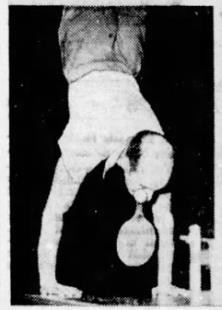

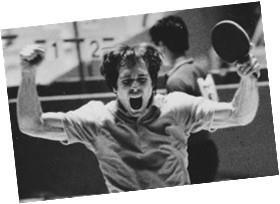








One can argue that he was the best player never to be world singles champion. This Hungarian made the finals three times, losing 3-2 to Zoltan Mechlovitz in 1928, 3-1 to Victor Barna in 1930 and 3-2 to Barna in 1934. He earned his seven world golds with six team titles and one mixed doubles.
Yet you may instead think of Laszlo Bellak (1911-2006) as a great table tennis exhibitionist. If this is our exhibitions issue, with its Globetrotters coverage, we want to spotlight Bellak, too. (The wonderful French exhibition duo Jaques Secretin/Vincent Purkart certainly merits future coverage.)


His athletic youth set the groundwork. In a 1943 interview, Bellak said, “When I was 13, I was one of the best swimmers and soccer players in Budapest.” He said he switched to table tennis because it had wealthier backers and better trophies. When you see Bellak return the ball with his forehead or the back of his foot, think of his soccer expertise. When you see him perform leaps or handstands, think of his diving-board skills. When he keeps a ball aloft by blowing, imagine the trumpet career he passed up.
In 1940, Bellak joined the U.S. Army, having become a citizen. More from that 1943 interview: “I will make the Army my life’s work... I appreciate this country. It is the best in the world and I have lived in most all of them.” He unconsciously dusts the chevrons on his uniform. “Table tennis? It was fun for the first 22 years. I was getting around the world in grand style. But someday the legs give out. The eyes don’t see so well. And where are you?”
As it happened, Bellak later found a career he preferred to the Army: the printing business.
The interviewer finished the article this way: There’s only one angle of globetrotting he’d like to try again. Playing before the Maharajah of Mysore, the richest man in the world, he heard applause coming from behind a screen. He tried to get a look at what he felt quite sure would be harem beauties. They probably were. But that, as the man said when he looked at the ax, is no way to keep a level head in India.
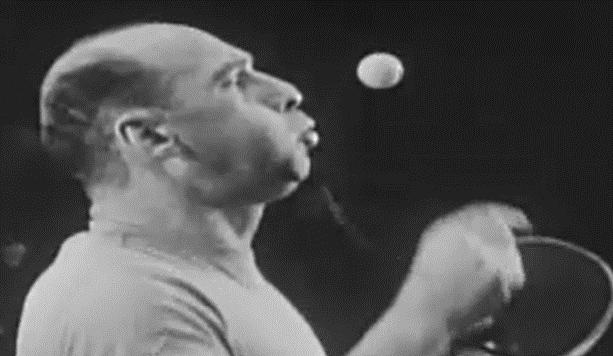

Here are two videos you can watch online: Bellak and Barna Bellak at 1946 U.S. Open, New York City
Table tennis exhibitions were popular in the 20th century. Tens of millions saw performances around the world. Many of those spectators were at the halftime shows of Harlem Globetrotters basketball games.
World-class players who traveled with the Trotters were, in chronological order, Doug Cartland of the U.S., Marty Reisman (U.S.), Dick Miles (U.S.), Richard Bergmann (England), Rene Roothooft (France), Norikazu Fujii (Japan), Bernie Bukiet (U.S.) and Dal-Joon Lee (South Korea). From 1948 through 1971, one or more of those eight stars performed with the Trotters every year. About two dozen other players were their partners or, as described in the pages after this article, traveled instead with the Globetrotter B or C teams. The Trotters never employed table tennis women, even though the one tennis star that traveled with them was the great Althea Gibson.

The Globetrotters originated in the 1920s. The 1930s and ‘40s saw the team tilt more and more towards tricks and comedy, though the halftime shows were still mainly skill demonstrations of basketball shooting. The comedy approach became especially important when the NBA finally began signing black players in 1950, gradually taking the best basketball prospects. The earliest table tennis halftime shows we found were in 1948. Besides table tennis, halftime soon also included acts such as acrobats, jugglers, singers, etc.
The table tennis show played up the comedy angle. While the crowds were highly impressed by serious play, especially the returns from 30 feet, they clearly enjoyed the myriad of tricks that became standard, such as hitting the ball with different implements or parts of the body. Usually one player would be the trickster/comedian and the other the straight man. The players were sometimes known as the “Globetrotters of Table Tennis.”
Here is the chronology of the star table tennis appearances. (One short bio of Laszlo Bellak says he did Globetrotter shows with Victor Barna, but we have not been able to confirm this.)
January through April 1948 Doug Cartland and Harry Cook of the U.S. are billed as “America’s No. 1 Comedy Sports Attraction.” The billing is notable because it shows that the Globetrotters basketball team itself still preferred to be known as the world’s best basketball team, which they arguably were in 1948. Cook was the comedian of the 10-minute table tennis performance the guy who, for example, would jump on the table and kick the ball over the net. Cartland and Cook had been doing exhibitions together for years, including a USO (military) tour throughout Europe in 1944-45. Their press notices said Cartland, 33, “graduated from the University of North Carolina with the highest gradepoint average in the school’s history.” More



important but unstated, Cartland was often among the top five ranked U.S. players. Cook had been a top-ten U.S. player in the 1930s; General Sportcraft produced a “Harry Cook” bat in the early ‘40s. Former track star Jesse Owens, employed by the Globetrotters for various roles, was sometimes the master of ceremonies for the evening. Owens also at times did halftime races versus basketball players, the length of the court; unlike them, he was required to jump hurdles.
The crucial job of the straight man is to always provide the perfect setup. Long before they joined the Globetrotters, Harry Cook and Doug Cartland meshed so well that they apparently merged into a single person named “Harry Cartland,” as captioned at left. This and the box at right are from the Michigan Daily, Nov. 14, 1941.

1948-49 season Cartland/Cook continued. The U.S. season usually ran from October through April, with summer tours then running in Europe or other continents.
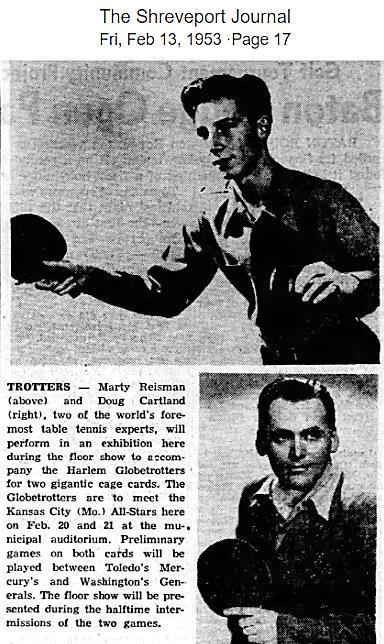
1949-50
Cartland/Cook continue until the spring of 1950, when Cook dies in a car crash that Cartland survives with only bruises.
Meanwhile, at age 20, Marty Reisman felt it was time to consider a responsible 9-to-5 job. After brief consideration, his conclusion was No, he was not cut out for that. Luckily, at that moment he had three table tennis offers on the table. From his book The Money Player: “One was an exhibition tour of France; the second for a tour of Sweden. The third was by far the best ... Doug offered me a job as his new partner and I accepted. I accepted immediately.” Reisman devotes Chapter VI of the book to Globetrotter stories. “I had the time of my life.”
1950-54

Reisman and Cartland remain through the 1953-54 season. The Globetrotter publicity material said, “Each at one time or another has been recognized as the world's champion.” In truth, they never won gold or silver at the World Championships, though each won multiple bronzes, including as a doubles team in 1952.


In the summers of 1950 and 1951, the Globetrotters do extensive European tours, playing perhaps 100 games each summer in 60 or more cities. Reisman/Cartland join them. Performing before a Berlin crowd of 75,000 in August 1951, they have a tough act to follow: Jesse Owens lands on the field by helicopter, makes an inspiring speech, and runs a lap to celebrate his return to Olympiastadion, where he had triumphed in the 1936 Olympics.
1954-55 Richard Bergmann, 36, joins the Globetrotters. He views the exhibitions as a great thing for table tennis and loves the travel see box at right from the Oct. 1956 English magazine Table Tennis and stays with them for the rest of his life, 15 years. Dick Miles, 29, is his first partner. They take a break in March 1955 for the U.S. Open, where Miles beats Bergmann 3-1 in the final.
1955-56 Miles is replaced by Rene Roothooft, 26, of France and Bobby Gusikoff, 19, of the U.S., who sometimes alternate day by day, touring the U.S., Mexico and Canada with Bergmann. The exhibitions were apparently not hurting Roothooft’s game in 1956 he won his third French title in both singles and doubles and his fourth in mixed doubles. Gusikoff, seen below at a Globetrotters game, would win the 1959 U.S. singles title.

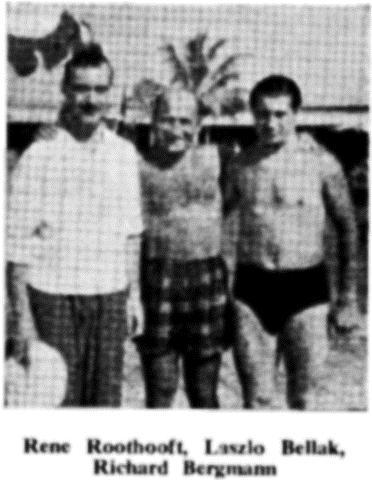

(Photo is from “Bobby Gusikoff: A Retrospective Compiled by Dean Johnson & Tim Boggan.”)
Summer 1956 Bergmann and Roothooft (right) tour with the Globetrotters in Latin America. At left, they visit with Laszlo Bellak, who was vacationing in Cuba.




Table Tennis Review, Mar.-Apr. 1950

1956-57 Roothooft breaks his foot in a car accident and is replaced by Bernie Bukiet (below), 37, a U.S. team member originally from Poland. Exhibitions didn’t hurt Bukiet’s game either, it seems the old man won his first U.S. singles title in 1957 and then two more in 1963 and 1966.
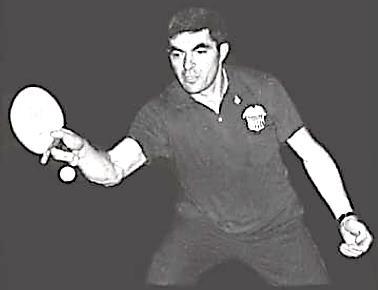
Summer 1957 Ken Stanley, 35, of England (right, with his son) joins Bergmann for a Globetrotter European tour.
1957-58 Bergmann and unknown partner(s)

1958-59 Norikazu “Cannonball” Fujii of Japan, 33, joins Bergmann for Globetrotter tours of Europe and the U.S. Fujii is suspended by the Japanese association for being a paid professional, which by ITTF regulations means Bergmann must be suspended by the ETTA for playing with a suspended player, and he is. Fujii was the 1952 world doubles champion with Tadaki Hayashi and was Japanese champion four straight years, 1946-49 (seen at right in 1947).
“No one in the game hits the ball harder than Fujii-San,” said Bergmann. “His game is attack, attack all the time. All I do is drop back 20 or 25 feet and let him wear himself out.”
Summer 1959 Bergmann/Fujii do ten different European countries with the Trotters.

1959-60
Bergmann/Fujii
Summer 1960
Bergmann in England with unknown partner(s), not Fujii.
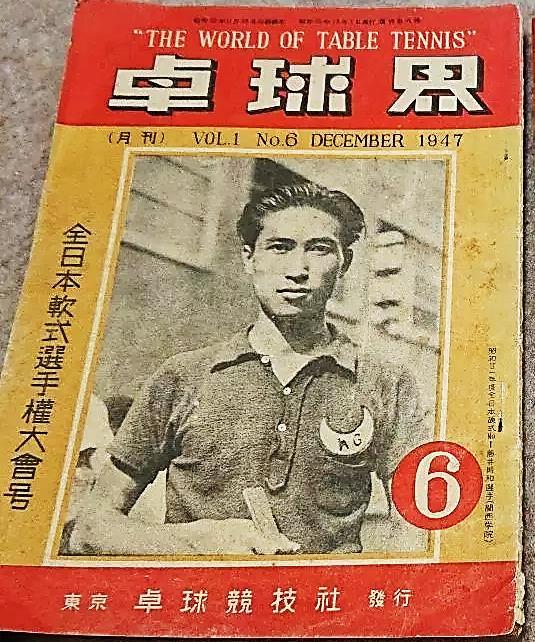
1960-61 Bergmann registers a company named World Professional Table Tennis Promotions Ltd. This is a packaging of his Globetrotter halftimes, with four players himself, Fujii, Roothooft and Bukiet competing for prizes for the best tour record, with a total purse variously stated as $10,000 or $21,000. Jack Kramer was doing a similar thing in the world of tennis, attempting to professionalize the sport.

January 1961 A Globetrotters TV broadcast includes Bergmann/Fujii. Rerun in August 1961.
April 1961 Bergmann/Fujii, no further mention of a pro world championship
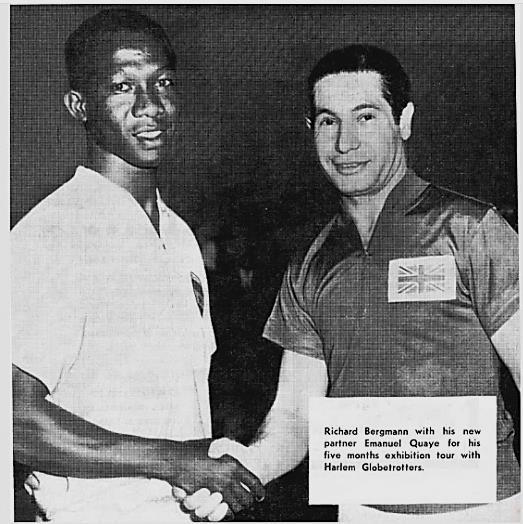

1961-62 Bergmann’s new partner is Emmanuel Quaye (left), 23, of Ghana, who would win the African singles championship in 1962 and 1968.
1962-63 Bergmann begins the season with Quaye and ends with attacker Chou Lin Chen (right) of Taiwan.
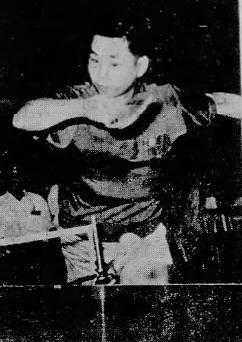
August 1963 Bergmann/Chen join Globetrotter tour of Scotland and Ireland.
1963-64 Bergmann’s new partner is Brazilian sensation Ubiraci da Costa, 18, a penhold attacker known as Biriba. This photo is among many in a Swaythling magazine article about him, October 2021, page 26: Biriba

Summer 1964, 1964-65, 1965-66, Fall 1966 Bergmann’s new partner is Dal-Joon Lee, 25, several times champion of South Korea. They also do a part-summer 1964 gig in England at the Pontins Holiday Camp (below), unrelated to the Globetrotters.


Bergmann/Lee visit about 60 different countries over these 2½ years. Said Lee: “It was exciting for the first six months. But I had no privacy. And later, I began to feel like a piece of luggage.” Escondido Times-Advocate, June 11, 1972. Afterwards, Lee moved permanently to the U.S., won six straight U.S. championships (1968-73) and gave exhibitions throughout the country.

Jan.-Feb. 1967 Bergmann’s partners are Shonie Aki, 30, a top-20 U.S. player, and Steve Kesler.
Spring 1967, 1967-68 Chen returns as Bergmann’s partner.
1968-69 Fujii replaces Chen but leaves in January for a family emergency. His place is taken at various times by Bob Hanson of Spokane, Tommy Ruttinger, 17, of Seattle and Derek Wall, 38, a South African living in Canada. Wall has been quoted as saying, “Richard would put everything he had into our half-time act. Afterwards, sometimes, he’d literally be sick, would puke in the privacy of our dressing room.”
1969-70 Bergmann/Fujii are the scheduled pair for the new U.S. season, but Bergmann collapses during an exhibition in England and is hospitalized. His place is taken by Noeh Simhock, 24, of Malaysia.
April 1970

1970-71 Fujii’s new partner is Jack Bender of England. Fujii was the last of the world-class players to travel with the Globetrotters. His base in Miami was Fujii’s Table Tennis Club. He returned for one more Globetrotters season in 1974-75, partnering with Charles Butler, 21, of Texas (or “Africa,” as the team publicist preferred), who afterwards had a long pro career in Germany.
The Globetrotters typically had multiple teams on the road, covering different regions of the U.S. or traveling abroad. Naturally each team needed its own table tennis duo, thereby providing employment for lesser players. Of course, every player was billed as an amazing champion, and certainly spectator John Q. Public could not tell the difference. All the players were quite skilled enough to put on entertaining shows.
Here are those players:
1948-49 Ted Bourne and Syd Cohen are the first table tennis B team, while Cartland/Cook as detailed in previous pages are traveling with the A-squad basketballers. Bourne/Cohen are billed as “foremost contenders for the world pro title,” and later as “world’s professional table tennis champions.” Bourne, 36, was a naturalized U.S. citizen who never lost his Birmingham, England, accent.

1949-50 Bourne’s new partner is Lee Webb of Detroit. See article at right for bios on each.
Feb. 1950 Webb is replaced by George Ferris of Connecticut, billed as the New England Open champion and former national doubles champion, with “one of the world’s greatest retrieving defenses.” (Fact-checking U.S. Open records, Ferris only once made the finals of an event, when he won Consolation Singles in 1947. He did attain a national ranking of No. 12 in 1952.) Among the gigs of this pair was a three-day stint with the Globetrotters in Cuba, seen by 15,000 spectators. Below in Havana, Bourne (on the left) and Ferris play with four balls simultaneously.
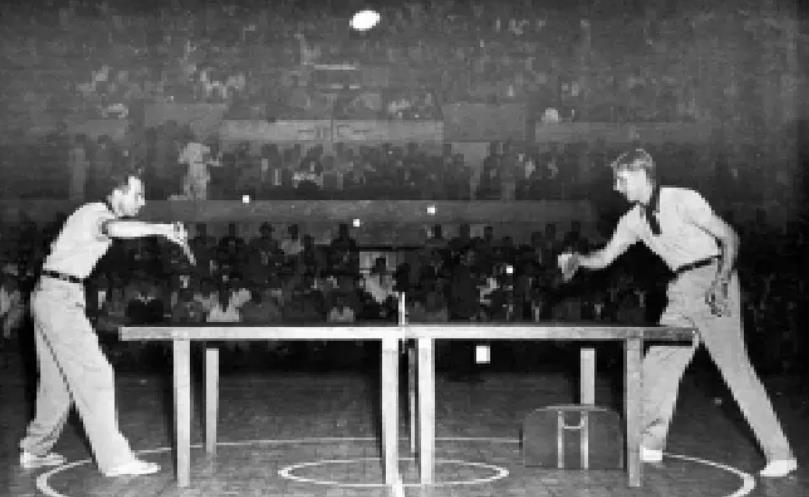

1950-58 Bourne’s new partner is Bob Anderson of Chicago, a former army pilot who had ranked No. 5 in the U.S. in 1940, the year he was national mixed doubles runner-up with Mayo Rae Rolph. They stay with the Globetrotters until Anderson dies on the final day of the 1957-58 tour, apparently from complications of diabetes. Bourne continued playing recreationally until his 70s, dying in 1984 of a stroke while at the table in a Florida tournament. According to his wife Lori, that was how he always said he wanted to go.
1958-62 Unable to find any table tennis B Team for these years.
It’s time to introduce Bob Ashley of California, who will be with the Globetrotters on and off for 15 years, starting in 1962. By then, Ashley was an old hand at exhibitions. Here he is (below) in 1951 with penholder fellow student Kiang Hing Choi at the University of Southern California. We zoom in on the enthusiastic crowd in front of the promotional banner, the kind of support that surely inspired his future such endeavors.

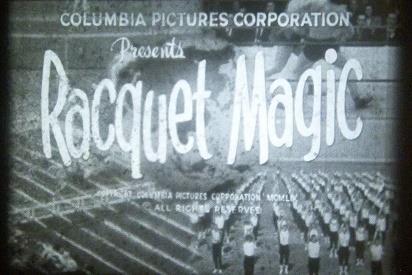


Years later, in movie theaters around the U.S., Ashley starred in an outdoor exhibition filmed in Las Vegas, released in April 1959. He would have been about 27; his two 18-year-old co-stars were the junior champions of the U.S., Lenny Cooperman and Sharon Acton. Veteran sportscaster Bill Stern narrates the ten-minute 16mm film, Racquet Magic, which we recently acquired, digitized and put on YouTube, here

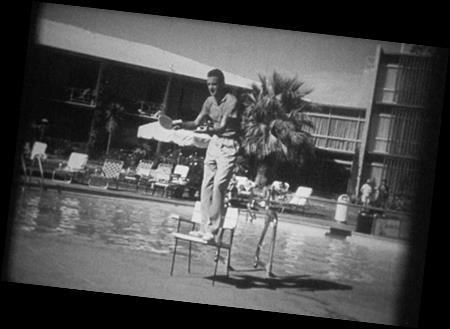
1962-63 and 1963-64
Ashley does Globetrotters halftimes with Dennis Hickerson, 20, born in Los Angeles but living in Sweden since age 14. Picking up table tennis at age 15, Hickerson was that country’s junior champion at 16, and its men’s champion at 19. He then turned pro and captured the pro crown of Finland, Norway and Sweden. Or so says the imaginative publicity material. “He is currently Sweden’s number 1 ace.” Showing admirable restraint, they did not claim he was world champion. The same press notice said Ashley had been the U.S. Armed Forces world champion, twice champion of Mexico, and the winner of the national college title and 22 state titles.
1964-65 and 1965-66
Unable to find any B Teams for these seasons.
Summer 1965 Ian Harrison, 26, multiple-times English champion, partners with Gerard Chergui, the 1963 French champion, for the Globetrotters’ European and Near East tour.


Summer 1966

Emmanuel Quaye of Ghana, who had partnered Bergmann in 1961-62, and Niels Ramberg, 20, a member of the Denmark national team (both pictured at right), do the European tour. In 2023 Ramberg won the World Veterans over-75 division.



1966-67 Ashley returns and partners with Bernie Bukiet, who had first teamed with Bergmann nine years earlier.
1967-78 The B-Team era is essentially over. After Bergmann dies and Fujii mostly steps aside, the Globetrotters travel with a single table tennis duo, below world class. In 1972, Ashley, now in his 40s, takes over, with a different partner every year: in order, Darryl Flann, Simon Heaps, Steve Dodgen, Craig Aurelio, Greg Plakos and Mark Kennedy, all of the U.S. except the British Heaps, a teenage diabetic who carried a suitcase of insulin and syringes and is today a para champion.

We continue our analysis of the 101 issues of Table Tennis Collector/Table Tennis History Journal. Those issues can be viewed at https://www.ittf.com/history/documents/journals/.
Issue 56 ***Page 8. Discusses various international match disputes of the past. For enlightening details on some of these, see “Controversies” in this issue, page 24
Issue 56 ***Page 19. Shows unusual racket creations of Filipino artist Peter Cua and discusses the Liha sandpaper-racket game. For more, see “Sandpaper Beauty” in this issue, page 48
Issue 57 ***Page 6. “The Mystery of Annie Hall” tells the story of the huge, months-long 1923 Daily Mirror tournament. For the latest findings, see page 30 of this issue.

Issue 58 ***Page 6. I have not been to China, so I was grateful a few years ago to learn of our colleague Graham Trimming’s posting of 199 photos he took at the museum complex there, Table Tennis Museums Shanghai September 2019 | Flickr. Looking through them, I suddenly saw an exhibit (left) that looked very familiar. The museum took the images directly from my TT Collector article “When Ping Pong Came to Asia.” They also used some of my text description. Graphic artist Remya Warrier had helped create not just the map but the look of the whole article (and it shows!), as well as Part 2 in the next issue. It was quite a surprise to see this exhibit, since our contribution, our existence, was never acknowledged. (Remya also helped design the cover of Ping Pong Fever: The Madness That Swept 1902 America Speaking of which, the museum shop would do well to add the book to its shelves.)
At right is our original map, a guide to ping pong sites described in the Issue 58 article. Do you notice anything missing from the museum version? How could they erase our little ping pong ladies?!

Issue 58 ***Page 12. Gerald Gurney visits Guernsey, the island off the coast of France. In this issue, we show you a Ping Pong war of words that broke out there in 1902 see “Real Men Fire Rifles” on page 34.
Issue 59/60 *** The life of 1920s Austrian player Hans Lowy is the subject of a two-part article by his grandson. Important omissions and misjudgments are revealed on page 23 of this issue.
Issue 59 ***Page 14. Shows a silver bowl that appeared on eBay. Here is the story behind it: Mrs. Charles Farnsworth was 31-year-old Edith Winslow Farnsworth, married to an 1889 Brown grad who was in the gold-mining business up on Cripple Creek. She won this pretty bowl in the women’s Ping Pong competition at the Colorado Springs Town & Gown Golf Club, said the local Gazette, April 8, 1902. She and the men’s winner both used a leather-covered wood bat, “which seems to be the most effective kind for a fast and accurate game.” The “large and enthusiastic gallery impartially applauded the good strokes of both winners and losers.”

Issues 59/60 ***Our colleague Jorge Arango of Colombia provides 1901 evidence that he believes pinpoints when the English firms Jaques and Hamley became jointly concerned in Ping Pong. Our colleague Michael Thomson of Scotland added further evidence in Issue 101.

Issue 60 ***Page 10. Gerald Gurney discusses the origin of the St. Bride Vase (left, held by Victor Barna), the men’s singles world championship trophy. We flesh out “The Story Behind the Name” on page 26 of this issue.
Issue 60 ***Page 13. The table tennis tradition of Oxford vs. Cambridge is related by Gerald Gurney, who attended both universities. We unearth some of Mr. Gurney's personal playing days on page 32 of this issue.
Issue 61 ***Page 5. Shows publicity cards of Bergmann and his exhibition partners. On page 6 of this issue, we examine the history of the Harlem Globetrotters halftime exhibitions, with Bergmann playing a major role.
Issue 61 ***Page 19. Shows the book Table Tennis Among Jews in Poland (1924-1949) by Wieslaw Pieta of Poland, English edition. In 2011, along with Aleksandra Pieta, he published a paper “Czech and Polish Table Tennis Players of Jewish Origin in International Competition (19261957).” You can read it at Jewish Champions, which actually covers all of Central Europe and beyond. Pieta is seen at right in 2023.


Issue 61 ***Page 19. Shows the new book Operation Mincemeat (2011) because Ivor Montagu plays a part and not a good part. The famous ruse, in which misleading papers were planted on a corpse, allowed the Allies to successfully invade Sicily in 1943. Ewen Montagu (right), Ivor’s older brother, had a leading role as Lt.-Commander in British naval intelligence. There were fears that Ivor would surreptitiously obtain and then leak information. Yet when Ewen wrote his 1956 book on this caper, The Man Who Never Was (made into a 1956 movie of the same name), Ivor went entirely unmentioned. In that respect, the 2011 book and the 2022 book-based movie broke new ground. Ivor is played in the movie by Mark Gatiss (above), whose impressive roles in recent years have included King George III and actor John Gielgud.

By the way, some WWII deception efforts were more successful than others. For example, the Germans built a fake wooden airfield, meticulously well done. The Royal Air Force showed its appreciation by bombing it. What kind of bombs did they use? Wooden bombs, of course

Issue 62 ***Page 6. Claims to show the “earliest evidence of Table Tennis broadcast on television,” February 16, 1937. But in Issue 66, page 10, we learn of an earlier broadcast at the same location, the BBC television studio at London’s Alexandra Palace. Noted in the final entry of the November 12, 1936, schedule at left, this was a ten-minute exhibition by the Hungarians Barna, Szabados and Bellak, with W.J. Pope as referee. All four men had their faces and hands “yellow ochred” to offset image distortions. (The following dayps and weeks saw radio coverage of the England vs. Hungary exhibition tour, such as a 20-minute commentary by D.W. Miller during play at Memorial Hall, London.)

Three months later the telecast referenced in Issue 62 aired. It staged two full rematches of the just-concluded English Open finals but shortened to best of three. Barna again beat McClure, but Kettnerova with a 2-1 win reversed her 3-2 Open loss to Aarons. The small studio space made it impossible for Aarons to use deep defense, her strength.
Issue 62 ***Page 10. David John Hughes discusses the history of Barna-endorsed bats. On this popular topic, see also TTC Issues 47, 67, 79, 80, 82, 86, 87, 89, 90 and 100.
Issue 63 ***Page 6. Our colleague Alan Duke outlines the life and circumstances of David Foster of England, who in 1890 patented “Parlour Table Games,” which included table versions of cricket, football and tennis. No Foster sporting connections are mentioned, so we can add that in 1892 Foster was elected vice-president of the newly formed Selby Albion Cricket Club, which was open to members of his cousin’s bible class and friends.
A second Foster set has since been found (Issue 74), demonstrating that the first-known set was not just a prototype. Another update is the discovery of the set’s rules pamphlet (Issue 80).

Foster was a respected community leader. At left is a letter to the editor that shows he could keep a sense of humor in the face of trying conditions.
See other Foster bio additions in TTC Issues 70, 77 and 97. Here is one new note: Foster’s work life included a close association with Procter & Co., merchants and cheese factors of Selby and Hull, and with its owners, the Winders family.
Issue 63 ***Page 29. Shows the cover of the 2008 book Pingpongista (“The Ping Pong Player”) by Jozef Hen (1923- ) of Poland, and wonders about the table tennis content. Answer: The tt content is minimal. Here is a translation of the abstract
“During the war, fourteen-year-old Michał Dembina tried to save his older friend, Zyga Ehrlich, with whom he used to play ping-pong, from a pogrom. It didn't work; the Jewish boy was shot in front of Michał. The novel deals with antisemitism in Poland and the role that the Poles themselves played in the Holocaust.”

Issue 64 ***Page 3. Shows photo (below) of the group that convened in Berlin in January 1926 to discuss forming an international table tennis organization. One of the men is identified only as “DTTB Treasurer,” and he gets the same nameless treatment when the photo is shown again in Issues 95 and 100. He stands fourth from the right, looking out from behind Mechlowitz. That is Fritz Zinn, 32, co-founder of the German TTA and treasurer from 1925 until forced out by the Nazis in 1933.

Issue 64 ***Page 4. Describes the new book Ping Pong Fever: The Madness That Swept 1902 America. Soon after, our colleague Dean Norman of Ohio wrote a play loosely based on the book, in two acts and titled “Ping Pong Fever”:

Write Dean at deannorman01@gmail.com for a free pdf of the play. Stage it at your local club, even with period costumes!


“A
Author Steve Grant discusses the good old days of 1902 with host Linda Eide of Norway TV for a sports history series. Issue 78, page 16, describes the filming of this 36-minute table tennis episode, which you can watch at Norway TV.
Issue 64 ***Page 5. Shows this 1902 lithograph, below left, by Russell Hoyt Daniell (18811911). Issue 94 published his related piece, below right. (He also did a horse-track litho that year in the same style, called “A Close Finish.”) Born into wealth in New York City, Daniell occasionally worked at the well-known Broadway department store John Daniell Sons & Sons, founded by his grandfather. In the summer of 1901, he was badly hurt in an accident (below). In 1902, about the time of these drawings, at age 20, he contracted tuberculosis. Two years later he moved to a “cure cottage” at the world-renowned Saranac Lake TB community in upstate New York, where he enjoyed drawing and the fresh outdoor air, before dying there in 1911.

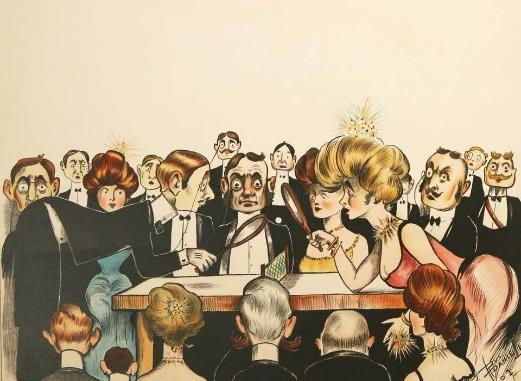

Issue 64 ***Page 12. Our colleague Gunter Straub of Germany contributes Part 2 of his article on the history of Defense. He states at one point, “The very first national champion of China, Chiang Yung-Ning (1952), was a penhold chopper, too. At the 1953 World Championships, Chiang defeated two-times world singles champion Johnny Leach. This was the first time an athlete from China beat a world champion in any sport whatsoever (James, 2010).”
This is wrong: They did not play one another in 1953. (Wikipedia repeats the mistake. Their cited source: Gunter’s article.)
Leach did lose to Chiang in 1956 Swaythling competition (right), by which time Leach at 33 was past his prime.
The November 1956 issue of Sin Chung Hwa (“New China”) carried an article about Chiang:

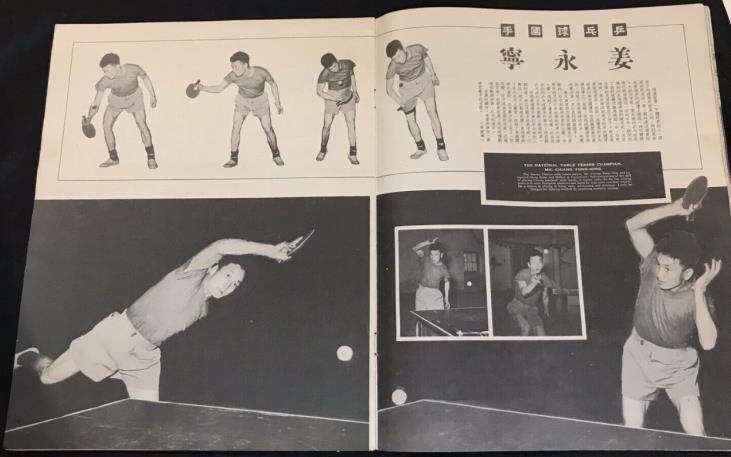
Tragically, during the Cultural Revolution, Chiang (1927-1968) was one of the three players who killed themselves after being accused of misdeeds.
Issue 64 ***Page 17. Our colleague Michael Thomson of Scotland states that the English firm Jaques would have infringed Parker’s trademark if it had named its USA set (right) Ping Pong instead of Table Tennis.
But maybe the case is not that clear-cut. This is from the NY Sun, Jan. 16, 1903:

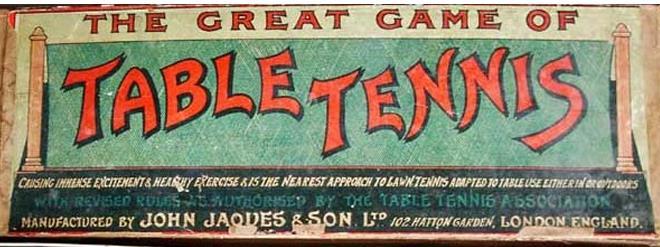
The attorney general ruled that the trademark law is designed to protect against fakes, counterfeits and deceptions, and that Hamley Ping Pong sets are nothing of the kind, so it was fine to import them. Likewise, one might argue that Jaques Ping Pong sets are nothing of the kind. But was Jaques situated differently? Its hypothetical case might be stronger if its sets were not specially made for the
U.S. market, and if Jaques actually owned the British trademark, rather than simply being jointly concerned with Hamley. Jaques chose not to test this.
This is part of Knox’s decision:



The California retailer A. Hamburger & Sons keeps the relationships foggy with this ad in the Los Angeles Times, July 15, 1902, using the term “agents” three times regarding Parker and Hamley.
Jaques stays in the game with “Pride of England” Table Tennis (near the bottom), though the description misspells Jaques. Well, even author Howard Jacobson misspelled Jaques, in The Mighty Walzer, while getting almost all the table tennis history correct.

Issue 65 ***Page 4. Our colleague Alan Duke does deep research on early patentee Emma Barker and her family, later updated in Issues 69, 70 and 97. Our own “Thoughts on the Barkers” are on page 47 of this issue.
Issue 65 ***Page 20. Alan Duke shows four 1888 British patents for table games meant to evoke outdoor tennis, none resembling the table tennis we came to know. Here is an intriguing 1886 French patent that we would love to learn more about, by a Mr. Fitz-Maurice:
Issue 65 ***Page 8. Excerpts from two 1902 diaries put us in the presence of early ping pong players. Here are two more entries from other diaries of the time:
May Bragdon (1865-1947), 36, was a single working woman in Rochester, New York, seen here in the center of the back row. To the right of May is her brother Claude Bragdon (1866-1946), noted architect, writer and stage designer. May writes in her diary on May 7, 1902, about sounds coming from the other room, where Claude is playing Mr. Humphrey, seen at lower left in the photo.

(“Charming Beauty Bright” was a popular folk song.)
Jennie Pease D’Ooge, married to a Latin professor at Michigan State and seen here at age 43 in 1900 with her four kids, likes pyrography and apparently dragons. She wrote this on August 20, 1902:

And one excerpt from a letter:
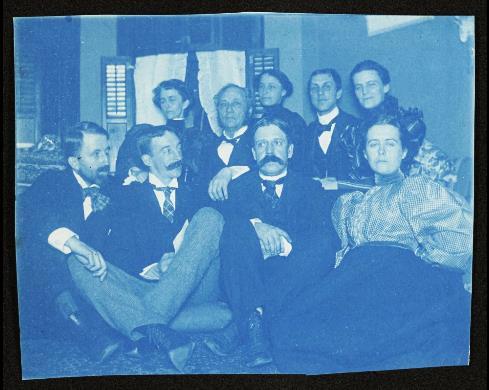

Ella Brewin, 30, while traveling in New Brunswick, Canada, writes to her mother back home in Middlesex, England. It’s interesting for the early Canadian date and the strung rackets: “June 19, 1901... Mary has brought back “Ping Pong” (but string bats) so everyone is learning. I suppose you & Agnes play now.”
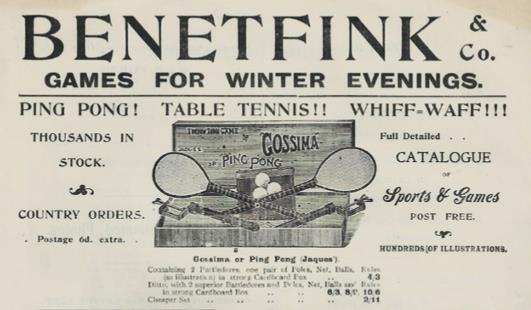
Issue 65 ***Page 19. We are shown this ad but given no date or source. Move ahead to Issue 81, p. 39, where we learn the ad appeared on the back of a November 1901 London concert program. This is an oddly late date to see “Gossima or Ping Pong.” Its replacement, “Ping Pong or Gossima,” was first advertised at least eight months earlier.
It’s natural for a descendant to want to think highly of his ancestor, and some exaggeration can be overlooked. So we give leeway to a grandson writing about his revered grandfather. But when a hagiography significantly distorts the public record of a public figure, should we just stand by? Historians cannot. Fairy tales are for grandchildren.
Austrian player Hans Lowy (1907-1993) was the subject of a long two-part article by his grandson Dan Edelson in TT Collector 59 and 60. Dan relied heavily on grandfather’s memoirs, apparently entering the project knowing nothing of the world of tournament table tennis and little of Lowy’s business career. While the table tennis years are the most relevant for us, we should address the entire article.
The article is headlined “Forgotten Table Tennis King of the 1920s.” In reality, Lowy was more a minor prince than a king. Dan writes that Lowy was among the top ten players in the world in 1924-26, and that these ten were of roughly equal caliber. That is a stretch. Though Lowy had some successes, primarily in doubles, there is for example no reason to think this teenager was the equal of the experienced Hungarian stars.
Dan notes that Lowy (and teenage teammate Robert Thum), though named to the Austrian team, did not actually play in the 1926 world championships in London, for some unknown reason. Dan is mystified, but sending a full team to distant events was expensive, and it was common in the early era to leave players behind (or even the whole team) when short of funds.
In Part 2, the last half is devoted to Lowy’s life after table tennis. In 1939 he and his wife escaped the Nazis and made it to America, where he changed his name to Lowey.
According to Dan, Lowey helped the U.S. war effort by producing water purification, disinfectant and other tablets. Not mentioned is that the War Production Board imposed “severe penalties” on Lowey’s firm in 1942, alleging that they resold their allocation of scarce chemicals on the black market for huge profits.

Somehow Lowey’s education credentials seemed to have been inflated in press articles of the 1950s. Dan says only that Lowey studied chemical engineering at a technical school in Vienna. Yet one newspaper report said Lowey earned a degree from the University of Vienna, and at least one other gave him the title of “Dr.”
Dan states that the company founded by Lowey in 1956, Forest Labs, became a multi-billion-dollar success. Not mentioned is that in 1977 the company and Lowey pleaded no contest to SEC charges of tax fraud, overstating revenue and diverting funds to a Swiss bank account. That ended Lowey’s time at Forest Labs. It was the firm’s subsequent leaders and restructuring that produced the big success.

An unrelated note on Part 1: In this photo, the gentleman third from the right is Lowy. Dan hazards a guess that the tall young man behind Lowy is Liebster. It is actually 18-year-old Sandor Glancz of Hungary.


Controversy roils every sport from time to time. In TT Collector Issue 56, editor Chuck Hoey discussed a dozen heated moments that have hit international table tennis over the years. Here we offer elaborations on three of them. The green boxes are from the Issue 56 article.
The details, as pieced together from Table Tennis magazine (England, April 1959):
Japan and Vietnam had gone undefeated in their Swaythling Cup groups, each with nine lopsided wins. Now, meeting in the semifinal, they were tied 3-3. Ichiro Ogimura was up 20-17 on Le Van Tiet (unstated whether this was Game 1 or Game 2) when he killed a ball for a winner, but the umpire ruled that he had moved the table with his foot and the score went to 20-18. The ensuing argument lasted 40 minutes, until the umpire was removed at Japanese request. Ogimura won 22-20, 21-19. Japan won the match 5-3 and then beat Hungary 5-1 in the final.


This was Round 2 of Singles. At right is the account by Mal Anderson (USA) in Table Tennis, May-June 1983.
Many years later, in 2020, Seemiler commented on the match on Facebook. “I got a little excited (see photo) winning the 4th game. The score was now 2-2 against World No. 2. It was always my dream to beat the Chinese in the World Championships. I was extra motivated in this match because Cai Zhen Hua was very disrespectful to me early on in the match. He was always like that with other players but no one ever took him up on it. Two times early on I popped up his serve and after he loop killed he did a full 360 making fun of me. I walked right up to him and said if you ever do that again.....I’ll leave it at that. I led 10-8 in game 5.” According to Seemiller, it was a fault serve to make it 11-8, not a let, and after a 20-minute dispute, the referee overruled and the score reverted to 10-8. Seemiller writes, “I lost my focus. Cai was nervous before the delay and I was nervous after.”

Back to Dortmund again in 1989, the same venue as the 1959 controversy above:


Sweden met China in the Swaythling Cup final. Each of the first three matches went the full three games, but Sweden won all three. In Match 4, Jiang and Waldner split the first two games. (Jiang, by the way, had beaten Waldner in the final of the world singles championship two years earlier.) In Game 3, Waldner takes a 7-5 lead. Jiang then backhand serves into the net to make it 8-5. He quickly picks up the ball and does the same serve (pictured below left), the ball again hitting the net but making it over for a let except the umpire fouls Jiang for tossing the ball from below the table surface, to make the score 9-5. As Mr. Clemett explained at left, that did not go over well. With the new umpire, Waldner extended his lead to 12-5 and won 21-16. You can watch it all on the video, picking up just past the 10-minute mark.: Waldner vs. Jiang 1989
Waldner won men’s singles, too, and here holds the St. Bride Vase.


Finally, a correction: The Issue 56 article mistakenly said that Richard Bergmann of England was barred from the 1947 world championships. That simply wasn’t true. He did find a way to stir up controversy there, though, as explained in our January 2024 issue, page 5.
The St. Bride Vase, awarded to the men’s world singles champion, was donated in 1929 by Corti Woodcock, a member of the St. Bride’s club in London. Gerald Gurney introduced the circumstances to us in TT Collector Issue 60, leaving some open questions. Let’s dig deeper.
Feb. 20, 1882. The St. Bride’s Youths’ Institute and Reading Room opens in an adapted warehouse, 11 Shoe Lane, in connection with Working Lads’ Institute. This club allows the hundreds of boys employed in this printing-trade neighborhood to “profitably spend the evening hours and so be saved from the temptations and snares of the streets, the public-houses, music halls, and theatres.” The Institute soon fields teams in boxing, track and field, swimming, chess and other competitions.
Nov. 20, 1893. The Prince of Wales (at right and quoted below) celebrates the memorial stone for a new building for St. Bride’s Foundation Institute, near the old building.



1922. The building is largely abandoned when St. Bride’s Institute outgrows it and moves to Stamford Street, south of the river, to become part of what is now the London College of Communication. The printing-trade library remains in the old building (even today), but much space becomes available for new uses to be determined.



The All-England Ping Pong Club forms. Austin Carris, “wealthy director of many companies,” is president. He is pictured below in December 1922.

1922-23. The All-England Table Tennis Club (renamed) rents splendid new quarters near the Royal Opera House (a mile west of St. Bride’s). England’s first-ever international match is held there in March 1923, versus Wales.
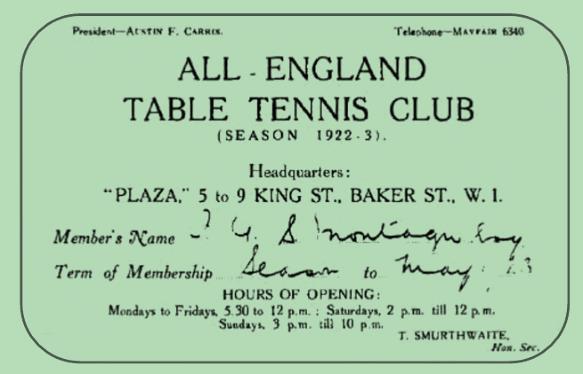



1923-24. But that location did not work out for some reason.
Daily Mirror, Oct. 17, 1923
St. Bride’s to the rescue!
Daily Mirror, Oct. 24, 1923


Soon, important table tennis competitions were held at St. Bride’s, such as late-round matches of the Daily Mirror tournament in 1924, and the England vs. Wales match in 1925. Gurney provides results of the 1928 City of London championship there, to which the TTC editor responds, No Ladies’ Singles? Answer: Ladies’ Singles was won by Joan Ingram. The City of London event actually began at St. Bride’s in 1927 and continued in 1929 (when Bull beat Perry in the final for the second straight year) and 1930 (actually Dec. 1929, Perry the winner), before moving to Memorial Hall.
The St. Bride’s building survived the war mostly intact, even while St. Bride’s Church next door was gutted. Tables were damaged in the Blitz, but play continued. In 1946, you could find many top players there, including Barna, Filby, Brook, Bubley and Carrington. As before the war, gymnastics, chess, debating, swimming and other activities shared the building.
But the St. Bride Vase was itself a war casualty. Somehow the plinth went missing no Vase base. The last winner before the war, in 1939, was Austrian Richard Bergmann, now an English resident, so was this his fault? We don’t know, but Bergmann had shown less than full respect for the Vase in the past. In his book Twenty One Up, he confessed to hocking the trophy the first time he won it, in 1937, the proceeds financing a fine dinner for a starving 18-year-old (himself). Table tennis authorities quickly ordered retrieval from the pawnbroker. In 1947, the ETTA agreed to bear the plinth replacement expense.
Bergmann 1948... Plinthless? The photo below, from his book cover, must be a composite with the old plinthless trophy pasted on, because in 1948 (below right) the trophy had a plinth. Either that, or he lost the plinth again


Bergmann figured in yet another episode in 1950. In the singles final at the world championships at Budapest, Ferenc Soos of Hungary refused to make any offensive shots, even when Bergmann
popped up the ball. Afterwards, donor Corti Woodcock was as usual given the opportunity to present the Vase in the award ceremony. But as he wrote in TT Review, March/April 1950,
“Both are defensive players and though the table they used was admittedly a slow one, there cannot, to my mind, be any valid excuse for the appalling exhibition they put on. A best of five games match, running its full course, usually takes half an hour, possibly up to forty-five minutes. This one, including the quite illegal breaks between the games, dragged on for an hour and three quarters. Incidentally, it so happens that it was I who donated the World's Singles trophy twenty years ago (in honour of Fred Perry's victory at the time) and in disgust at the execrable, pitiful performance, I flatly declined to present the Cup to Bergmann.”
Others criticized that stance and said Bergmann was simply doing what he had to do to win. Bergmann himself had plenty to say about the Woodcock comments, which made him “sore as hell.”
Interesting that Woodcock called it a Cup...
Let’s look at what everyone is really wondering about but dares not mention
--- the more mysterious part of this trophy’s name.


Look at these two awards. Which is the Cup and which is the Vase?
(Left, St. Bride Vase for men’s singles world champion.)
(Right, Iran Cup for men’s doubles world champions.)
I guess we just have to accept it?
China, on its 1981 postage stamps, simply called them the St. Bride Trophy and the Iran Trophy, using the word bei 杯 (here circled in red)



Left, holding the wrong trophy, 2011 doubles champions Guo Yue and Li Xiaoxia.
Right, Ma Long receives a halfsize replica to keep after winning it three consecutive times.
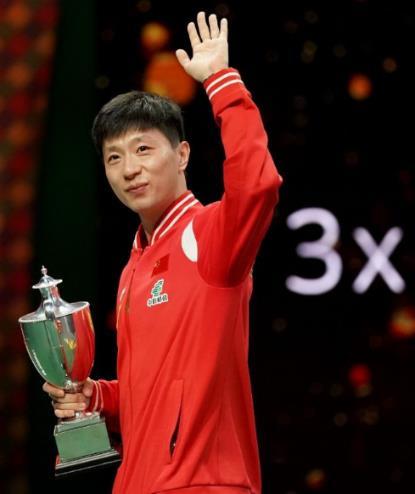
Annie Hall of Nottingham, England, died in 1976. The Woody Allen film by the same name came out in 1977. The person and the film were entirely unrelated.
“The Mystery of Annie Hall,” in TT Collector 57, explored the story of an odd table tennis trophy, inscribed (right) “United Kingdom Table Tennis Championship, Second Place, Won by Miss Annie Hall, May 2nd, 1923 ” If it was from the mammoth Daily Mirror national tournament, why didn’t it include the newspaper’s name in the engraving? Moreover, the actual tournament name was “All British,” not “United Kingdom.”

The TTC article told how the Daily Mirror tourney revitalized the game of table tennis across Great Britain. Regarding Annie Hall, the conclusion was that the well-deserved trophy was a gift from her family, since Annie’s actual tournament prize was “only” a fur coat, no trophy.
Further research has helped fill in some gaps:
Born in about 1894, the youngest of six children, Annie Selina Hall never married, living her entire life with her unmarried older brother and sister. They moved three or four times, staying always in Nottingham.
That brother was Henry Cecil Hall (1885-1970), right. In November 1922, he started the Nottingham Table Tennis Club, probably motivated by the recently announced Daily Mirror competition, for which he was a local organizer. Henry was president of the club and Annie was a member. They competed against teams from nearby clubs. Two matches made the local newspapers of Feb. 6 and 9, 1923:



Henry had business careers in liquor sales and as an estate agent, but his lifetime passion was collecting art, especially Nottingham artists past and present, about whom he wrote books and articles. I suspect it was Henry who had that special trophy engraved for Annie. After the Daily Mirror tournament, it seems Henry and Annie never show up again in the table tennis world, with one exception: Annie entered the first world championships in December 1926, but her opponent won by walkover.

Many top players entered the Daily Mirror tournament, of which a dozen men and two women were handicapped by five points. Zone winners and runners-up received medals. Below is the medal won by Godfrey Decker, who went on to distinguish himself in service to the table tennis world. Decker (right) had an excellent 1923 season, taking the Southwest London championship with wins over Dr. A.A. Fyzee and George Ross on March 3rd, and then the next week going 8-0 in the match against Wales He later became known for his lighting expertise at all the major tournaments for decades and was an officer of the ETTA.


The Daily Mirror coverage had difficulty getting the ages of contestants correct, and that led to errors in the TTC article. The men’s winner James Thompson was 34 or 35, not 32. The women’s winner Kathleen Berry was 14 when she won the Harrods tourney, not 13. She was 19 when she competed in the 1926 Worlds, not 18. Berry kept a hand in the game for years: At the 1934 Worlds, she made the semifinals of mixed doubles and the quarterfinals of women’s singles and doubles. In 1935 she again made the quarterfinals in doubles.
Two photos from the 1922-23 Daily Mirror event:
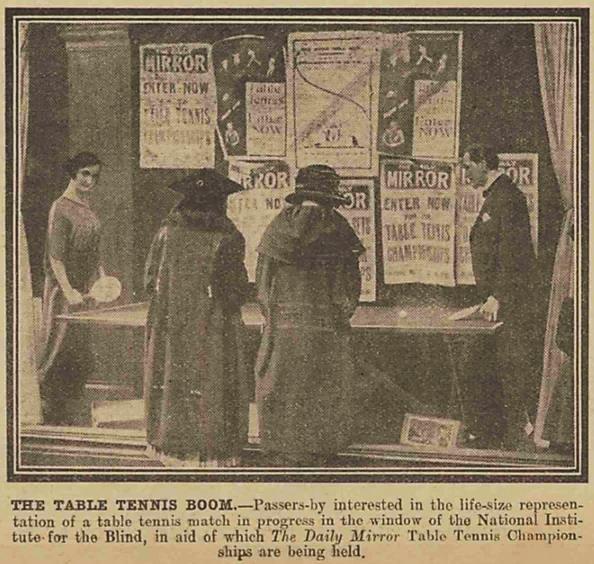


The 1952-53 results, Table Tennis, May 1953

Gerald Gurney reviewed the history of Oxford vs. Cambridge table tennis matches in TT Collector Issue 60, page 13. Gurney himself played for Oxford in 195253, 53-54 and 54-55, before his studies took him to Cambridge for the 55-56 season.
Whereas he was varsity 1st team at Oxford, he was 2nd team at Cambridge.
We thought it would be fun to look up the match results of his Oxford years.


1953-54, Table Tennis, April 1954

1954-55 results
Left, Birmingham Post, Feb. 25, 1955
Right, Civil and Military Gazette (Lahore), Feb. 26, 1955

Looking at the 1953-54 results on the previous page, you see notations after Gerald Gurney’s name that include “M.D. title B.A.O.R.” In 1950-52, Gurney was in the British Army of the Rhine (B.A.O.R.), the occupation forces in Germany, where he was a corporal in the Royal Army Ordnance Corps. As for “M.D. title,” in the book The Long Patrol: The British in Germany Since 1945, by Roy Bainton, 2003, Gurney is quoted:
“Fear of the Redland forces was nothing compared with the possibility of losing one’s rifle, which had to be carried at all times. Despite these war games and camping out in the bitter cold, my doubles partner and I won the BAOR table tennis championship on the day after our return.”
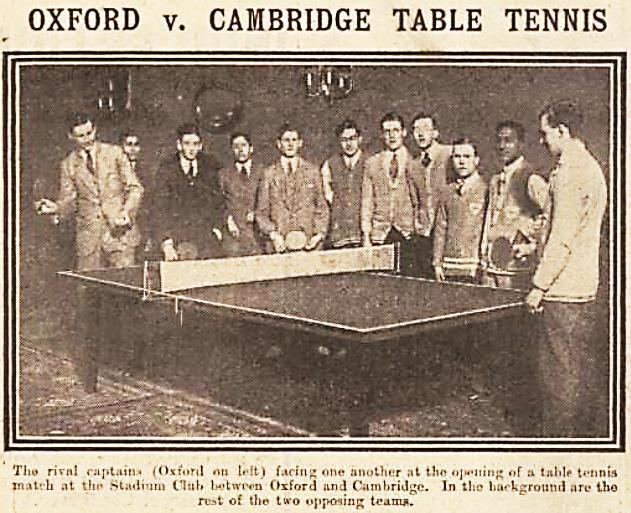
Daily Mirror, March 25, 1924
The Oxford/Cambridge rivalry continues today. Gurney won a half-blue, the top honor in his time. Today, Oxford awards discretionary full blue for men and half-blue for women. Cambridge considers table tennis basically a half-blue sport, but in 2023 they awarded one full blue, to a woman.
In TT Collector Issue 58, page 12, Gerald Gurney wrote that Ping Pong came to Guernsey, the British island, in 1922. He must have meant that was when the Guernsey TTA was founded, because of course Ping Pong had spread twenty years earlier to all English-speaking countries (and many others).
This February 1902 letter to the editor appeared in the Guernsey Press:


108 years later in the same newspaper:

That drew immediate heated responses from several Ping Pong players:




The tournament referenced in the letters started at 6:30 pm on Feb. 28 and went almost five hours, with 61 players, all men, on three tables (left). Winner was L.G. Cohen, who reportedly received tumultuous applause and a gold medal. Offensive skill was still underdeveloped in Guernsey three of the rallies in the final (a single game to 30) exceeded 150 strokes.



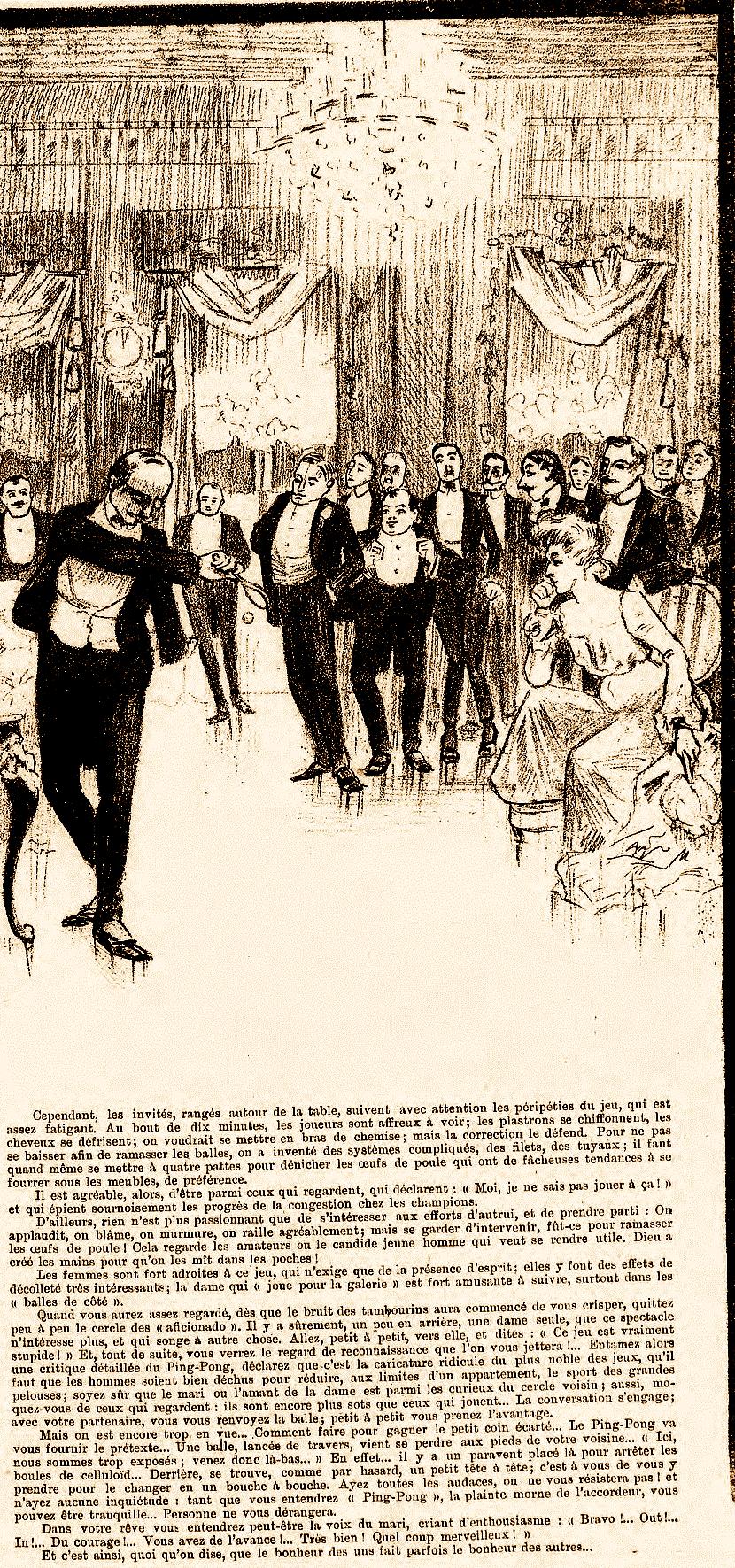
It was fatal! Now it's our turn. Ping-Pong crossed the Channel about a year ago, and it's wreaking havoc on us. We're beginning to have "Plng-Pong Parties" just like on the other side of the water. We no longer dance, we no longer talk: we play Ping-Pong.
This is, under a vaguely Chinese name, simply table tennis: but there is a special table where the courts are marked, only for Ping-Pong. It would be a desecration to put on it, in ordinary times, the slightest knickknack, or even a newspaper.
After dinner, quickly dispatched, we move into the living room, or rather the Ping-Pong room. And the session opens: Two partners grab the small rackets, a kind of tambourine mounted on a handle. It's very chic to have your own ping-pong racket, just as you had your own tennis racket. The players start sending the little celluloid balls back and forth over the net. Each time the ball hits the taut skin of the racket, it resounds with “Ping! Pong!” For the unfortunate neighbors trying to sleep, an evening of irritation begins, for the sound of “Ping! Pong!” brings to mind the monotonous, melancholy, tortuous wail of an out-of-tune piano. After an hour, it's enough to drive even the calmest of listeners mad.
But the guests, arrayed around the table, carefully follow the game's progress, which is quite tiring. After ten minutes, the players look dreadful, their suits crumpled, their hair mussed. They are tempted to dress down to shirtsleeves, but correctness forbids it.
To avoid bending down to pick up the balls, we've invented complicated systems, nets and pipes, yet sometimes we still must get down on all fours to collect the hen's eggs, which have a nasty tendency to get stuck under the furniture.
It's nice, then, to be among those who look on, who declare, "I don't know how to play!" and slyly spy on the progress of their champion among champions. Besides, nothing is more exciting than taking an interest in the efforts of others, and taking sides: One applauds, one blames, one murmurs, one mocks agreeably; but refrain from intervening, even if it's to collect hen's eggs. That's a matter for amateurs, or for the candid young man who wants to make himself useful. God created hands to be put in pockets.
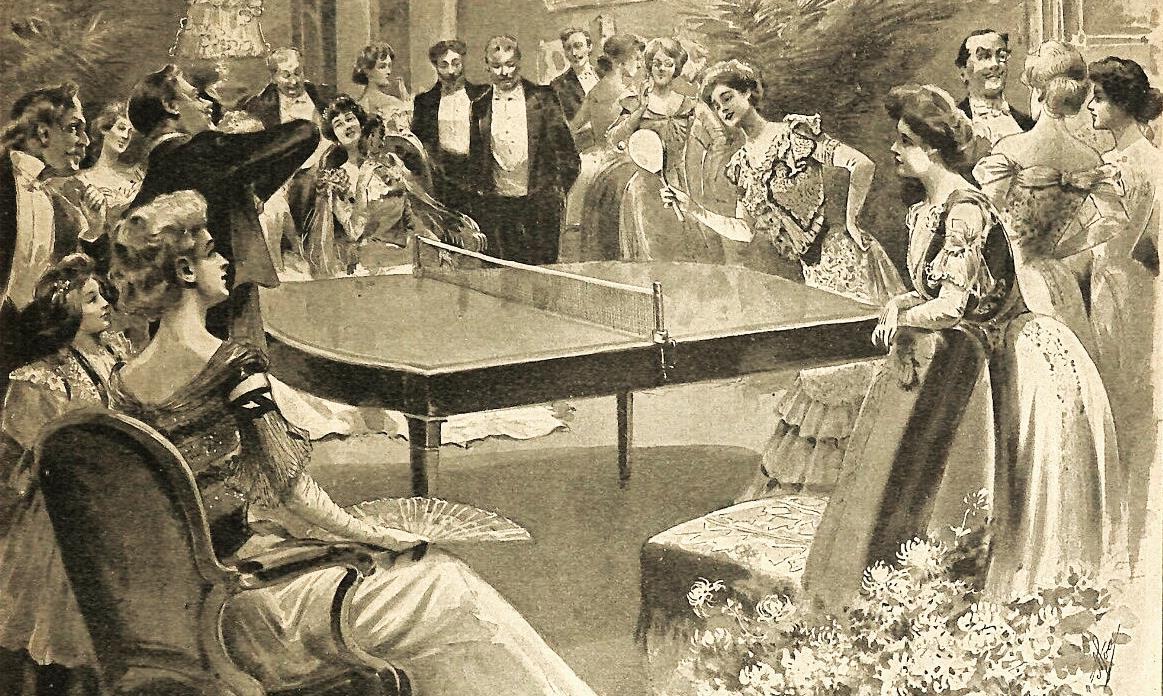
(from Williams & Cie. ad, Dec. 1901)
Women are very adept at this game, which only requires presence of mind; they produce very interesting cleavage effects; the lady who plays to the crowd is very amusing to follow, especially in the “side balls.”
Once you've watched enough, and as soon as the sound of the tambourines starts to make you tense, leave the circle of aficionados. There's sure to be a lonely lady a little way back, no longer interested in the show, who's thinking about something else. Go, little by little, to her, and say: “This game is really stupid!" Right away, you'll see the look of recognition you get! Then start a detailed critique of Ping-Pong, declaring that it's a ridiculous caricature of the noblest of games, that men must be very fallen to reduce the sport of large lawns to the confines of an apartment.
Be sure that the lady's husband or lover is among the curious onlookers in the neighboring circle. Make fun of those who watch: they're even more foolish than those who play ... The conversation begins; with your partner you pass the ball back and forth; little by little you gain the advantage.
But we're still too far away... How to win the little corner... Ping-Pong will give you the pretext... A ball, hit the wrong way, gets lost at your neighbor's feet... “Here we're too exposed; come over there”... Indeed... there's a screen there to stop the celluloid balls... Behind it, as if by chance, there's a little tete-a-tete; it's up to you to change it into a mouth-to-mouth. Don't be afraid: as long as you can hear “Ping! Pong!,” the dull wail of the tuner, you can rest easy... No one will disturb you.
In your rapture you may hear the husband's voice, shouting enthusiastically “Bravo! Out! In!... Courage!... You're ahead now!... Very good! What a wonderful shot!”
Thus, whatever one may say, one man's happiness can create another man's happiness...
At the first-ever big tournaments in London, December 1901, solid wood rackets, either covered or uncovered, were just becoming the most popular choice. Strung rackets and vellum drumheads, judged inferior, were on their way out, essentially extinct a year later.
Or so we thought. So it was shocking like spotting a dodo bird when we found major French retailers still selling sets with strung or vellum rackets well into the 1920s, while giving at best secondary nods to the wood rackets that the rest of the world was using.

For a casual home game, that equipment might be OK, but for competing in open tournaments, it would be an embarrassment. Children growing up with inferior rackets were unlikely to be the champions of the future. Late to the organized game, France formed its national federation only in 1927 and first entered the world championships only in 1932 (going 0-9 in Swaythling, but soon rapidly improving), whereas a dozen other nations had already played in earlier Worlds.
When collectors come across a strung-racket set, it is likely to be French. Let’s look at some early French sets.
Examples of the set at right appeared in TT Collector seven times. If not rare, it is certainly an attractive set, with its wood box, beautiful sliding lid and well-built strung rackets. All seven of these well-cared-for sets came with rules still present and intact.


Below is the cover of those rules “S. & B. Paris” must denote the maker of the set. A small drawing of a knight helmet is seen within French words that mean trademark. We know nothing about S. & B. Paris, but the retailer of the set was a successful mail-order company. Their mark is on the underside of the lid (right):

“Manufacture Francaise/Armes et Cycles/Saint-Etienne,” it says. Established in 1885, the company sometimes called Manufrance was known for huge catalogs that featured sporting guns and bicycle equipment, much of which they manufactured themselves. But the catalogs also included a variety of other offerings, mostly from third parties.
We were able to examine most Manufrance catalogs from 1890 to 1925. Lawn tennis first appeared in the 1899 catalog. Table tennis made its debut in 1902, with vellum rackets (right).


The 1902 cover (left) showed the conjoined company founders. At right is another page from that catalog.
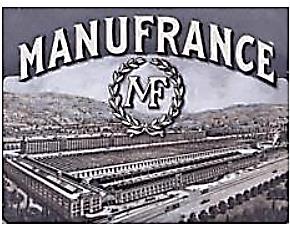

Near the front of the 1903 catalog is an introduction, in French of course but then translated into 14 other languages, demonstrating the international diversity of their customers. Here is their English version:

The 1903 catalog gets more serious about table tennis:

Translated, in part: “The great popularity acquired in a short time by garden games such as tennis and croquet has led to the creation of scale models that do not require much room.... The success achieved by these parlor games has. been considerable because they provide a delightful distraction on bad-weather days and during the winter season. They allow you to take exercise without going out and are a happy change from indoor games such as checkers, chess, dominoes, etc.”

At left is the full page and, at right, another enlargement. This appears to be the set we are looking for, the popular set that made it into the hands of today’s collectors, with strung rackets (“real gut”), folding net platform and a wood box that takes a sliding lid. Balls are feltcovered. The catalogs continued to offer this set, unchanged, through 1911.

Two more enlargements from that page:

At left is the other set they were offering in 1903, with “polished hardwood bats,” which appeared in their catalogs through 1912. At right is their listing for extra strung rackets and balls, with regular balls for set no. 230 and covered balls for set no. 235.


(Left): The 1904 catalog added a ball pickup device.
(Right): New in 1905 was a combo set of croquet and table tennis, with gut strings and felt-covered balls. The combo was discontinued in 1911.
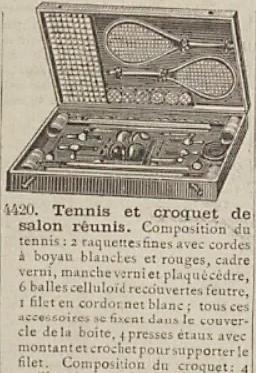

A cheap low-end set was added in 1911, with vellum rackets.
Strung rackets disappeared for the next decade. You could get plain wood or vellum rackets from Manufrance in 1912 but only vellum in 1913, 1914 and 1920. (We found no catalogs for the war years 1915-19, nor for 1921.)
Strung returned in 1922! (with much price inflation) ...and continued through at least 1925, the year that is pictured here:

In the other set, above, those sure look like vellum rackets, but the description says sandpaper-faced wood. That happened because this was a parchment-racket set in 1922-24, and in 1925 they changed the rackets but not the illustration. For the following years we were unable to find catalogs.
Let’s turn to another French retailer, Au Bon Marché. The set at right is from their 1904 catalog, published in late 1903. It came with both balls and shuttlecocks! .... and your choice of either vellum or strung rackets. The same set was offered for at least two more years, but only with vellum.

Table tennis fell out of the Au Bon Marché catalog for a long period, probably from about 1907 to 1922.
Below is from their 1923-24 catalog, still with vellum, but no more shuttlecocks.


Their table tennis sets carried vellum rackets through at least 1931....

...before they finally switched to wood rackets with faces covered with cork, rubber or cork/rubber combo by the 1932-33 season.
We examined one more French retailer that issued big catalogs, Mestre and Blatgé. Here is their offering from 1914, the Jaques “Ping Pong or Gossima”:
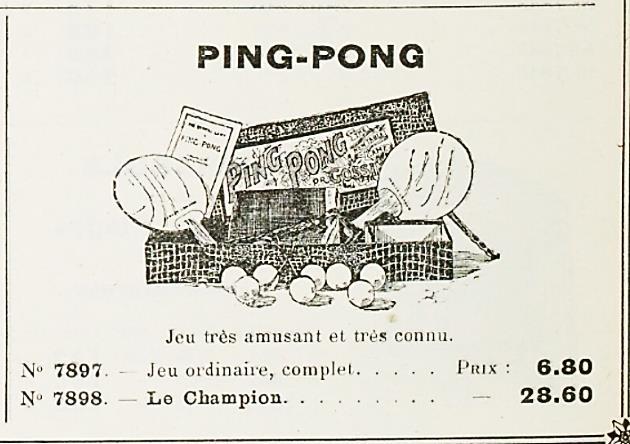
The box design is not one I have seen before, with “The New Table Game” in the upper right instead of the upper left. The rackets appear to be wood.
But then at right is their 1926 table tennis set, with hard to believe strung rackets.
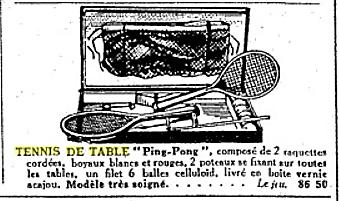
So those are the three big catalog/department stores. By comparison, sporting goods specialty retailers may have done better for their customers. For example, in 1907 the French retailer A.A. Tunmer (founded by an English athlete) offered no vellum or strung, only plain wood or sandpapercovered wood:

By the way, Tunmer also specialized in apparel for recreational activities. If you were a frequent flier in 1913, for example, they had you covered, with a canvas suit (goggles sold separately).


In the leading table tennis countries, England and the U.S., vellum or strung table tennis sets were unavailable after the 1901-03 introductory years. Even as early as May 1901, in The Echo, Jaques in London said of strung rackets, “We have tried them, and they destroy the whole science of the game.” Jaques did still offer gut rackets and covered balls in a 1902 catalog, but accompanied by a rare consumer warning: “(not recommended).” As for vellum rackets, a U.S. store explained in September 1902 why it was almost giving them away (right):
We’ll let the 1902 A.G. Spalding U.S. catalog have the final word:


George Lefèvre (1877-1961), pictured, was a young writer for L’Auto-Velo, an upstart sports journal in Paris trying to grab circulation from rival Le Velo, George’s previous employer. To promote readership, he came up with the idea of sponsoring a big table tennis tournament, perhaps even a world championship.
In the Feb. 1, 1902, issue he wrote (translated):
For more than a month, we have been receiving every day 20 to 30 letters from serious Ping-Pong players who ask us to organize a tournament. To tell the truth, we thought about it long before, but it is a big job: We need regulations, premises, prices, what else! We had to take care of everything.

Today the matter is almost complete; it is sufficiently advanced to be able to affirm that it will happen. The first Ping-Pong tournament organized by Auto-Vélo will take place soon.
Spread the word!
Géo Lefèvre.
On Feb. 2, he wrote:
The announcement we made yesterday of a great ping-pong tournament immediately earned us a large number of very enthusiastic letters.
Ping-pong, this table tennis, is indeed the fashionable winter sport and it counts today champions of skill and extraordinary people whose names are well known, since they are the stars of major tennis events. Ping pong is more than a fun game. It is also ... a real sport that has its varied tactics, its challenges and its twists and turns.
We are currently busy preparing very complete rules of the game and the tournament, and within a few days we will give [all the details].
Géo Lefèvre.
P. S. We received a communication from the Tennis Club de Paris ... informing me that the T.C.P. organized a tournament reserved for its members ... in its hall on February 9, 10 and 11. We welcome this, because it proves to us that the idea was in the air and that we did not go wrong when thinking about organization of an international tournament which will be the real ping-pong world championship, for which the Paris Tennis Club tournament and similar during the month of February will serve as a very worthwhile preparation.
Gentlemen champions of ping-pong, Practice!
Unfortunately, for unknown reasons, the tournament never happened, was not even mentioned again. Regarding that tourney at the Tennis Club, the two finalists were the de Pfeffel sisters, tennis champions who used vellum rackets. So much for George’s “gentleman champions.” Read about the sisters and Boris Johnson in “Boris is Tied to French Cover Girls...” at our TT History website.
George was primarily a biking enthusiast, it turns out, and a few months later he came up with a new idea to promote the newspaper a multi-stage, multi-day bicycle race. It was a success. Debuting in 1903, it is still held today under the same name, the Tour de France.


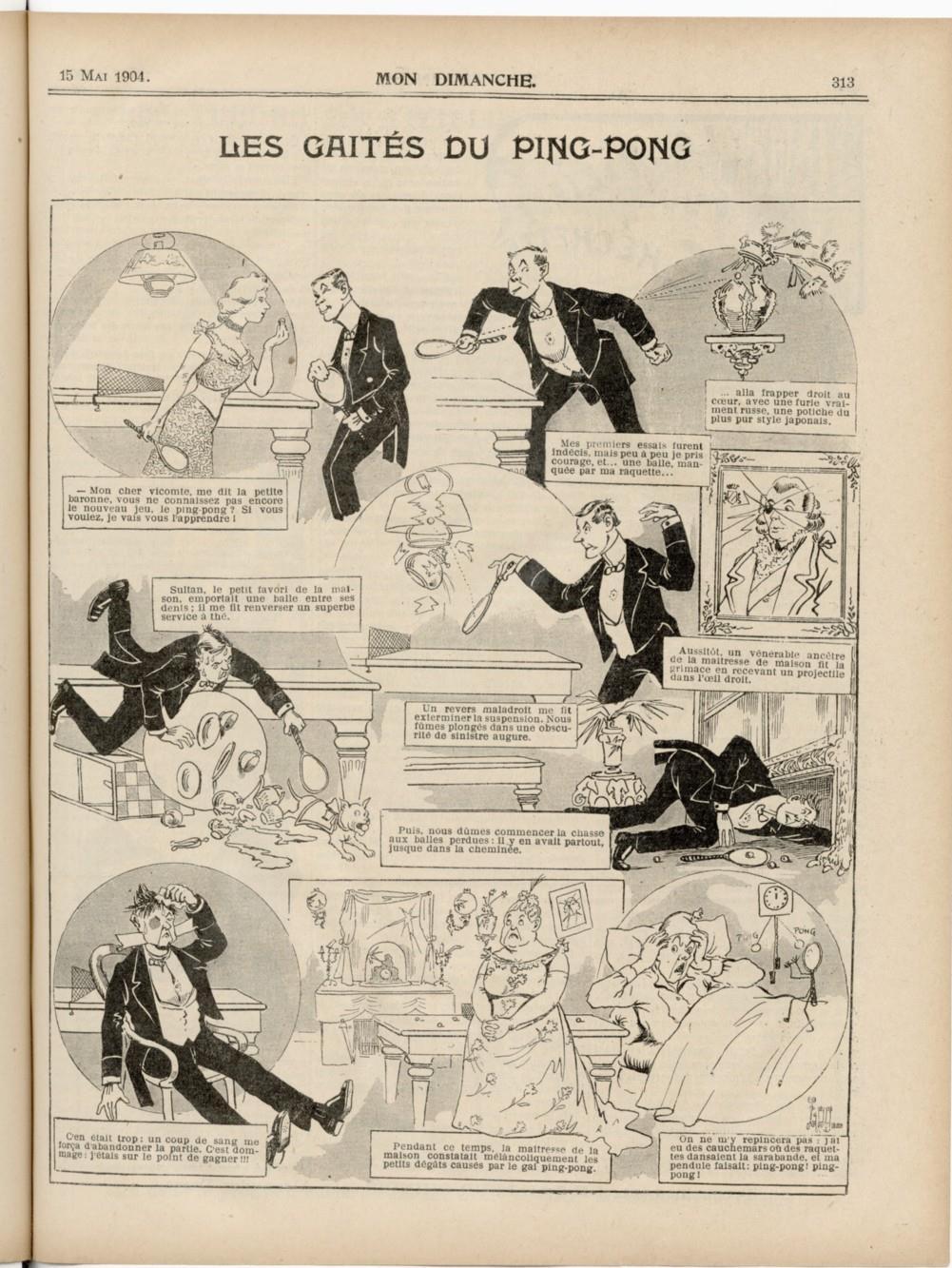







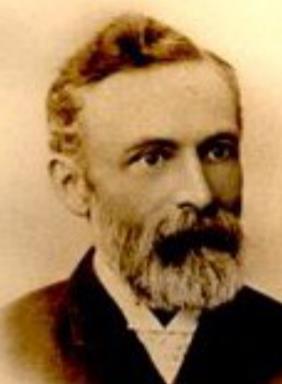
In TT Collector 65, our colleague Alan Duke teaches us much about the 1890 table tennis patentee Emma Barker of England and her family. Then in Issue 69, thanks to Alan’s discovery of an extraordinary essay by Emma’s son Fred, we learn it was really Emma’s husband Frank Cowlin Barker (left) who should get the invention credit. On reflection, it seems clear that Frank wanted to protect that patent asset by putting it in his wife’s name, keeping it out of the hands of his current or future creditors. Also important in Fred’s essay is his description of the game’s Cambridge residence origin, as well as confirmation of a Barker/Spalding connection. What a great piece of luck that Frank’s son saw fit to write that essay and that it survived to be found 80 years later.
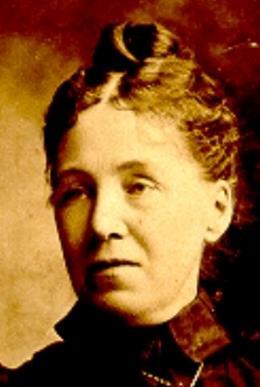
Emma was pregnant eight times in 13 years, 1869-1882. In the 1880s, busy corraling seven children, she probably wasn’t spending time inventing things, desperate though she may have been for new diversions for her kids. (But please watch out for that antique Chinese jar! Fred’s essay says the jar fell victim to table tennis.) Meanwhile, Frank had his hand in many businesses, always on the lookout for opportunities, and his 1874 patent filing (for improvements in books or pamphlets) showed an inclination for inventions.
Short lives seemed to be the rule among the Barkers. Frank’s father Francis Barker (1815-1870) was known as the top staghound man in his area, directing the dogs in the large-group deer hunts. He died at age 55 when his horse reared backward and fell on him not on a galloping hunt but at a horse show before a large crowd that included Prince Christian. Frank himself died young, age 59 of tuberculosis, the disease that impelled the move to New Mexico to prolong his life. Frank’s younger brother Phil, a dealer in horses, stayed in England and died of the same disease, age 50. The youngest brother Albert, who worked in Frank’s English iron business, was also a horse dealer. A horse kicked him in the head when he was 19, and he thereafter suffered from recurring seizures before suddenly dying in a rail car at age 31, March 1891.
One oddity: Emma Barker died at age 54 in 1902. Yet her age was given as 49 in the June 1900 census, with her birth year changed from 1848 to 1851. Vanity, one supposes. Her gravestone does not show a date or year of birth (TTC Issue 65), but Frank’s does (Issue 69).

The last two boxes on that census line (left) state that Emma has given birth to eight children, of which five survive. Her one child that Alan did not list was Fanny Cowlin Barker, born in 1872 in Spain but dying soon after.
A second oddity: In Issue 65, we are told that Fred had been “quite a table tennis player” and played the game regularly. (The source was Fred’s grandson.) Yet in his essay in Issue 69, Fred states:


This is Fred’s son Francis Barker (1919-2008) in California Frank’s grandson discussing his brutal experience as a prisoner of war in the Philippines, for the Veterans History Project. In the background is his wife Dee, demonstrating document-searching skills later put to great use in uncovering the essay by father-in-law Fred.
Peter Cua (1961-2014) of the Philippines was the Liha Ambassador. TT Collector Issue 56, page 19, discussed his international promotion of Liha, the table tennis variant played with sandpaper rackets. Besides being an excellent player, Peter was a craftsman who created extraordinary hand-made rackets.

Here is a good example of his artwork. Along with the Philippine flag, this museum-quality bat uses 86 pieces of nacre, better known as mother of pearl, the inner coating of mollusk shells.




Peter used his artistic skill at yet another passion miniature taxidermy. At right is one of his prizewinning creations, with covering made from fetal skins. Always a perfectionist, he insisted that every hair, every coloring, every detail, be precise and realistic.
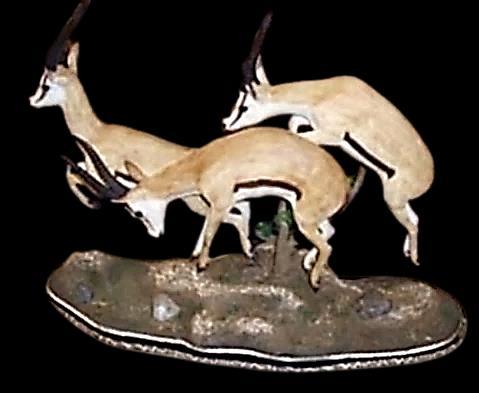
Thanks to Peter Cua, the 2010 U.S. Open included a sandpaper event for the first time. He led a Filipino delegation that traveled to the Open in Grand Rapids, Michigan. In a special ceremony, both the Philippine and U.S. national anthems were sung, followed by speeches.
The 2010 sandpaper event was not played under Liha rules, to which U.S. players were unaccustomed. (But Liha was added in 2011 through 2019.) Peter Cua won three matches but lost to Jane Hone Chui, -16, 11, 16, and (at right) to Ty Hoff, -16, 12, 18. In the final, Ty easily took the first game from Jane, 21-7. Our colleague Dean Norman of Ohio later wrote about it. “Ty was middle-aged, probably not as fast as when he was a kid. But man, was he fast on this day. When Jane hit a drive to Ty’s backhand, Ty ran around and hit a forehand counterdrive. Then Jane blocked to Ty’s forehand side, and Ty ran and blasted a forehand counterdrive past her.”

Jane was able to smile about Game 1 (left), but her body language said Defeat. (By the way, she is the daughter of Lim Ming Chui, U.S. men’s team member in the 1970s.)

Dean continues, “As Ty stood ready to begin the second, he turned to face the audience and shouted, ‘Am I a hitter?’ He didn’t intend to taunt Jane. He was just enjoying the match so much that he had to express his joy.”
Ty was obviously confident. But in the second game, Jane became more consistent her game was close-to-the-table blocks and medium-speed hits while Ty’s forehand kills became less consistent. She is seen at right immediately after pulling out a 2119 win to tie the match. The swing in confidence continued to go Jane’s way in Game 3, which she won 21-12 to become the first U.S. sandpaper champ. Jay Turberville, one of the entrants, videotaped this and other matches search YouTube for Sandpaper 2010.


Things were different the following year, 2011. This time, two of the very top Liha players made it from the Philippines, Richard Gonzales and Joseph Cruz. They swept all the hardbat and sandpaper open events. Their sandpaper final was full of hard forehand drives and counterdrives, superb backhand chopping, fine touch and deceptive dropshots, with excellent footwork farther from the table. By contrast, the 2010 final saw play close to the table, with very little chopping and with the kill shots coming mostly from one player. Here is the 2011 final: https://www.youtube.com/watch?v=hkK2fk4XBgg. The first game is somewhat ragged, but when they both get in the groove it is certainly pretty to watch.
Th
ose Philippine champs never returned to the U.S. championships, as far as I know. But there were plenty of good sandpaper matches still to come. Dean Norman tells us about one

“Ken Pinili (right, originally from the Philippines) and Adoni Maropis (left, of Los Angeles) asked me to be scorekeeper for their match in the sandpaper finals at the U.S. Nationals in Las Vegas in 2013. Bill Dorsch and I played many hardbat and sandpaper matches against Ken when he lived near Cleveland. After Ken moved to San Jose, CA, Bill urged him to enter the national sandpaper event. ‘You could win it,’ he told Ken.

“The prediction was coming true as Ken won the first two games at 21 and 17 with shots like the backhand shown here. Then Adoni’s chop defense steadied, and he won two games at 12 and 14. It looked like Ken was tired and Adoni would win the match easily. Adoni was accustomed to winning at the U.S.
Open five months earlier, he had swept the hardbat, sandpaper and Liha titles.
“But Ken started the fifth game strong and was leading 4-0. Suddenly, though, his left leg cramped up. He had played tough matches to get to this point, and now his body was rebelling. After trying one more point, he was still in pain, and Adoni suggested they take a break. Ken sat on the floor while friends tended to him. Adoni himself massaged the leg, and they wrapped it. Ken thought he could resume playing, though I worried his leg might cramp again, or he might play very tentatively.


“But no. Ken had played hard-hitting offense through the first four games, and now he hit even harder. He didn’t want long rallies, but there were some anyway. Adoni would chop back everything, but then Ken would find a way to win the point. He just couldn’t miss. Somehow his lead went from 4-1 to 15-1. Adoni looked at the score and said to me, ‘Don’t I have more points than that?’ I shook my head, ‘No.’ The final score was 21-11. I think everyone, including Adoni, was glad the match didn’t end because of an injury.
“Bill Dorsch phoned Ken that evening and said, ‘Aren’t you glad to be a national champion?’
“’I don’t know,’ said Ken. ‘I hurt all over.’” In the years ahead, Ken would capture additional national sandpaper and hardbat titles.
(This edited account of the 2013 match is adapted from Ping Pong, Anyone? Or Table Tennis?, by Dean Norman, an Iowa champion in the 1950s. The 65-page book, illustrated with Dean’s own cartoons, has interesting stories from his 70-plus years in table tennis, told from an engaging personal perspective. For a free pdf of the book, write him at deannorman01@gmail.com.)
Over 600 miles west of Ecuador lies the Galapagos Islands, where visitors can expect to see plenty of giant tortoises, sea lions, bluefooted boobies and Charles Darwin’s finches. Table tennis, not so much.
So when I recently spotted this building through the van window on San Cristobal Island, population 7000, my jaw dropped. I had to go take photos and learn more.
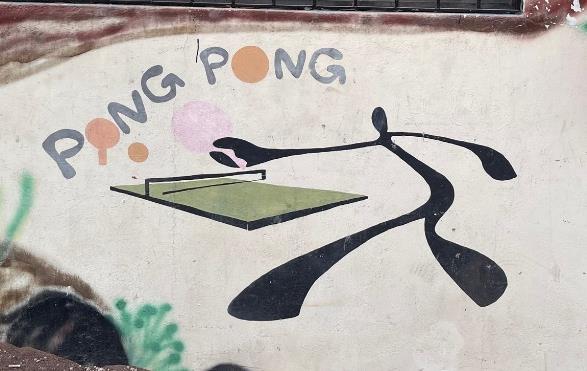


The sad news is that the club had to move out last year because the building owner had a different purpose in mind. The happy news is that the players found a new home and have not only survived but thrived. For tournament competition, they fly three or more hours to Ecuador.


The primary objective of the Club is to strengthen the principles and values in our young people, cultivating sports and personal skills that make them a valuable contribution to our community in the future.

de
of France, seen at the 1935 World Championships, where she made the quarterfinals of doubles and mixed doubles.
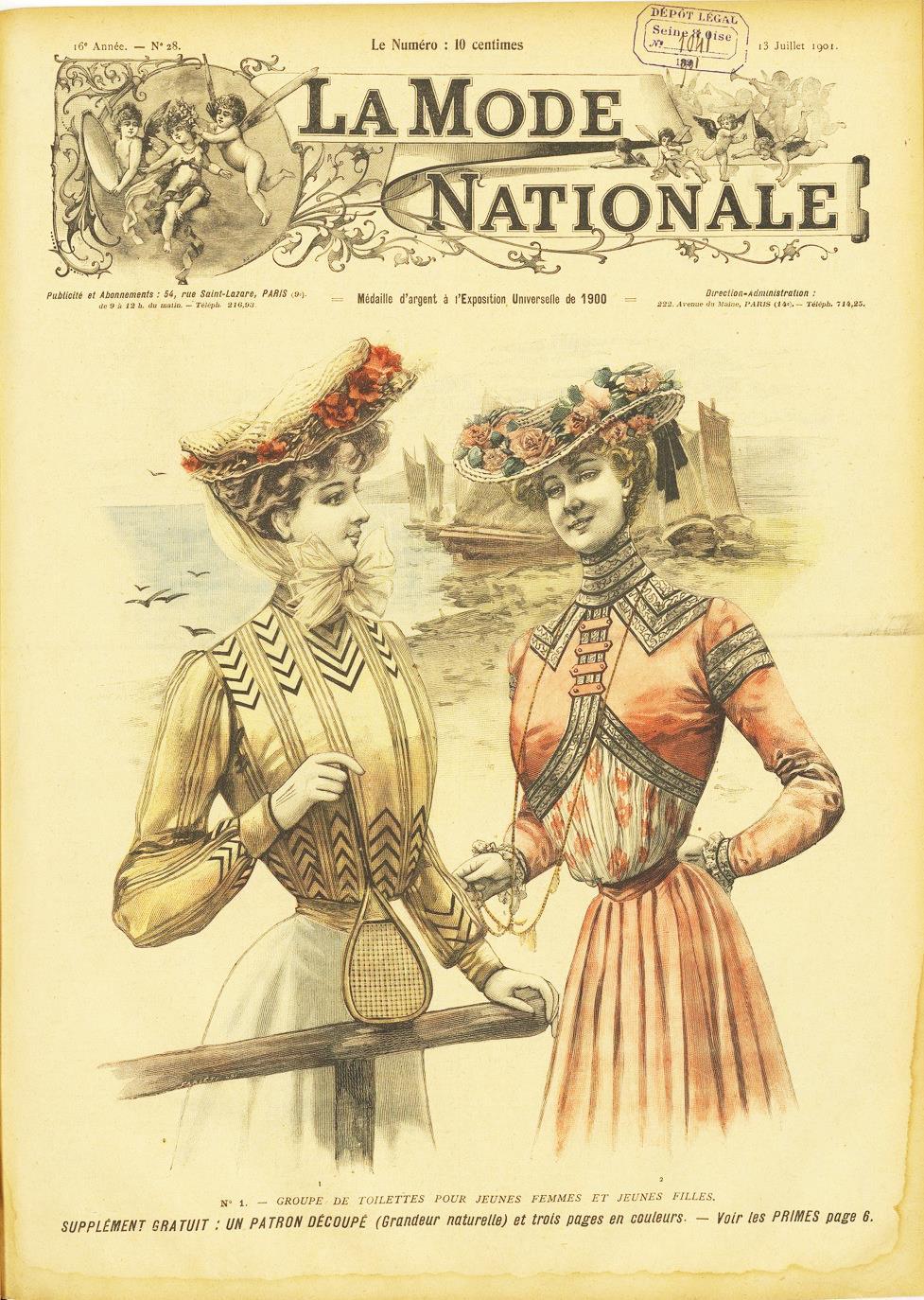

Team uniform, Wisconsin style, 1902. Cane rackets, single-sheet vellum. Woman at right is named Martha Quade (1879-1947).